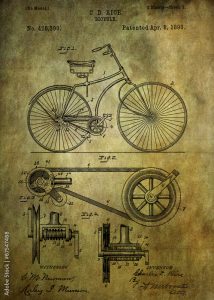The origins of rolling bearings
Did you know that the precursors of rolling bearings already played an important role very early on? For example, at around 2500BC, heavy loads were already transported from A to B on skids in ancient Egypt. Later, rollers were placed between the transport surface and the skids. With this strategy, the gliding motion was thus replaced by a rolling motion, which is still used today. A pivotal event in history was the invention of the Wheel. First made of stone, then later of wood. A challenge, however, was the friction within the wheel hub, which led to severe wear and tear. Even Leonardo da Vinci (1452-1519) was already thinking about how bearings could function with minimal friction. Powerful, isn’t it?

Da Vinci and the rolling bearing
Da Vinci’s ideas were generally very progressive. As early as 1500, he made some sketches, drawings and designs on the subject of ball bearings, which interested him in the context of his development of the Helical Air Screw (a kind of helicopter). In this way, da Vinci was able to gain his first insights into a low-friction bearing.
The importance of rolling bearings during industrialisation
The bicycle had a decisive impact on the development of the rolling bearing. After the invention of the Draisine in 1817, which already vaguely resembled a bicycle, both the treadwheel and the rear-wheel chain drive were developed in the second half of 19th century. Since people had to propel the bicycle themselves, the desire for low-friction movement finally increased. This created a high demand for industrially manufactured ball bearings. Finally, Friedrich Fischer designed the first fully automatic ball milling machine with which steel balls could be produced instead of stone balls. From 1886, Fischer even manufactured entire ball bearings. A short time later, NTN began producing ball bearings in 1918 and has since become one of the largest manufacturers worldwide.

Enough history lessons: Since Fischer’s invention in the 19th century, ball bearings are probably the best-known rolling bearing type, but not the only one. You can find out more in our article on rolling bearing types.
You may also be interested in
Basics and areas of application
What is a rolling bearing? Would you like to learn more about rolling bearings? Then you’ve come to the right place. But let’s start with
Materials and manufacturing
Materials and manufacturing Have you already had a look at our chapter on structure and function? Maybe you asked yourself what rolling bearings are actually
Rolling bearing types overview
If you have read our article on rolling bearing basics, you probably already know that rolling bearings can basically be divided into two types –
Structure and function
Components of rolling bearings The basics of rolling bearing technology include the structure and function of rolling bearings. To get you started slowly, you will
The cylindrical roller bearing
Characteristics of cylindrical roller bearings Do you remember the characteristic that all roller bearings have in common? We are talking about line contact, which can
The deep groove ball bearing
Characteristics of deep groove ball bearings In its current form, the deep groove ball bearing has existed – subject to some optimisation – for about




